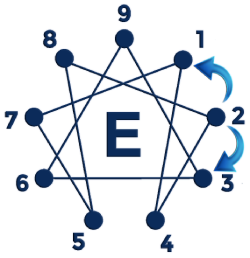
Understanding Wings
In the Enneagram system, "wings" are the two adjacent types on the Enneagram diagram.
These neighboring types provide additional qualities to your primary type and can somewhat affect how you exhibit your main type's characteristics.
The theory of wings suggests that each Enneagram type is influenced by one of its neighboring types.
For example, if you're a Type 2, your wing could be a 1 or a 3. You would then be referred to as a "2w1" (Type Two with a One wing) or "2w3" (Type Two with a Three wing).

While your primary Enneagram type represents your core motivations, fears, and desires, your wing complements that type and adds important, sometimes contradictory, elements to your personality.
This makes the whole system more dynamic and nuanced, offering a more comprehensive description of human personality.
The influence of wings varies among individuals. Some people might strongly relate to one of their wings, almost equally as they do to their core type.
Others might relate minimally to their wings. It's also important to note that people can't have a wing of a type that isn't directly adjacent to their core type. For example, a Type 4 can't have a 7 wing.
For more information on the Enneagram System, please visit our Understanding the Enneagram FAQ for more information.
|

Ben Baker, CEO
About the Author
Ben has practiced Astrology for over 35 years and is a certified Cognitive Behavioral Therapist (CBT) Practitioner. Ben holds 11 patents for the core functions that all dating sites now use today. See Ben's Bio for more info.
|













Comments